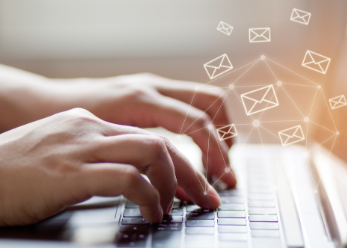by Casey McCormick, PhD

Wherever you work in higher education, email probably takes up a huge part of your daily routine. An overflowing inbox causes anxiety, a rude email can ruin your day, and that message-you've-been meaning-to-send takes up vastly more mental space than it should.
Despite email's omnipresence in our lives, there are very few hard-and-fast rules about how to do it, and differing communication styles can lead to misunderstanding, email bloat, and hurt feelings. So, if you're looking to establish some best practices and improve your digital communication acumen, read on to learn how to write better emails.
Formatting and Basic Etiquette
The most important aspect of any email is clarity -- ensuring that the recipient knows exactly what you want to convey. In addition to clear and direct language, simple formatting choices can improve the readability and flow of your email. Use line breaks to separate the greeting, body paragraph(s), and sign-off, and bold key dates or numbers to make them stand out. Keep your email as concise as possible: short sentences, 1-3 sentences per paragraph, and an overall length of no more than 150 words.
As for which salutations to use, follow the advice of journalist Victoria Turk in her 2019 TED talk. She recommends using "Hi" rather than "Dear," unless it's a particularly formal context, like an event invitation or job application. Turk also insists that "there is a correct way to sign off an email. It is 'Best wishes.' 'Best' and 'All the best' are also acceptable." Importantly, she urges email writers never to use "thanks in advance" as a sign-off: "You can't thank someone for doing something before they've agreed to do it -- that's not how gratitude works." If you're dealing with an email chain or thread, Turk notes that it isn't necessary to repeat salutations with each new message, as that could ruin the conversational flow. But if it's a new day, feel free to say "hi" again.
The subject line is a useful tool for bringing specificity to your email communication. A detailed (but succinct) subject description signals to your recipient exactly what to expect in the message so they are prepared to extract the appropriate information. It also makes the email easy to find later if anyone needs to search their inbox for the thread. Finally, when dealing with group email communication, make sure you follow "the CC rule," as Turk calls it: "Primary recipients of an email, who are expected to respond, should go in the 'To' field. Other recipients of an email, who are not expected to respond, and who are included as a courtesy or for their information, should go in the 'CC' field." "BCC" should only be used to safeguard sensitive information in a large group or to avoid a "reply-all-pocalypse."
Tone and Style
While it can be tempting to use five-dollar words and descriptive detail to convey your knowledge and excitement about a subject, this type of writing is not conducive to a clear and concise email. Remember that the goal is to make reading your message as easy as possible for the recipient -- that means no extraneous information, no flowery language, and no jargon. As Turk argues, "good etiquette is not about the fancy flourishes, it's about respecting other people's time." One useful trick for ensuring your email flows clearly and conveys its point succinctly is to read the message aloud to yourself before sending it. Would you want to receive that email? If not, revise and try again.
Clarity and concision are the primary goals of any email, but Turk warns that it is also possible to be too concise. "There's a line where brevity crosses over into rudeness," she says. "A single word is not a sufficient message" and "no one is too busy for please and thank you." Remember that you're having a conversation with a human being -- use full sentences and a friendly tone. That's why Turk is "pro-emoji" in most email contexts: "Emoji are great at communicating sentiment; they're basically a digital stand-in for facial expression." Of course, be careful never to overuse emoji (or exclamation points!), but a few small punctuation choices or emoji gestures can make all the difference in how your messages come across to readers.
Kindness Saves the Day
Higher education can be a stressful place, and unfortunately, lots of folks are overworked and underpaid. Emailing requires serious physical and emotional labor, and a never-ending inbox -- especially if it's loaded with unnecessary or poorly written messages -- can contribute to symptoms of burnout. Make your number one goal "reducing the burden of email," as Turk puts it. Model clear, succinct communication, and keep your emails to business hours unless the matter is truly urgent. If you tend to work at off hours, use the "schedule send" function as a courtesy to your recipient.
Lastly, think about a time when you received an email that made your day better. Maybe they are few and far between, but there are no doubt moments where a kind message can change your mood and pull you out of an inbox slump. When digital communication feels natural and sincere, it becomes easier to write and takes less mental energy. With some practice and intention, you will be writing better emails and, by example, helping those in your network do the same.
This article is republished from HigherEdJobs® under a Creative Commons license.
